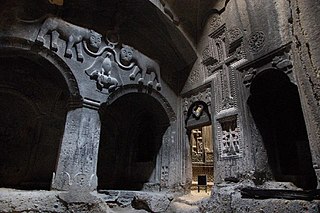
A monolithic church or rock-hewn church is a church made from a single block of stone. Because freestanding rocks of sufficient size are rare, such edifices are usually hewn into the ground or into the side of a hill or mountain. They can be of comparable architectural complexity to constructed buildings.

The Church of Saint George is one of eleven rock-hewn monolithic churches in Lalibela, a town in the Amhara Region of Ethiopia. Originally named Roha (Warwar), the historical and religious site was named Lalibela after the King Gebre Mesqel Lalibela of the Zagwe dynasty, who commissioned its construction. He is regarded as a saint by the Ethiopian Orthodox Tewahedo Church.

Lalibela is a town in the Amhara Region of Ethiopia. Located in the Lasta district and North Wollo Zone, it is a tourist site for its famous rock-cut monolithic churches. The whole of Lalibela is a large and important site for the antiquity, medieval, and post-medieval civilization of Ethiopia. To Christians, Lalibela is one of Ethiopia's holiest cities, and a center of pilgrimage.

The Zagwe dynasty was a medieval Agaw Orthodox Christian monarchy that ruled the northern parts of Ethiopia and Eritrea. The Agaw are a Cushitic ethnic group native to the northern highlands of Ethiopia and neighboring Eritrea. Centered at Roha, it ruled large parts of the territory from approximately 900 to 1270 CE, when the last Zagwe King Za-Ilmaknun was killed in battle by the forces of the Amhara King Yekuno Amlak. The Zagwe are most famous for their king Gebre Mesqel Lalibela, who is credited with having constructed the rock-hewn monolithic churches of Lalibela.

The Agaw or Agew are a Cushitic ethnic group native to the northern highlands of Ethiopia and neighboring Eritrea. They speak the Agaw languages, also known as the Central Cushitic languages, which belong to the Cushitic branch of the Afroasiatic language family, and are therefore closely related to peoples speaking other Cushitic languages.

Lalibela, regnal name Gebre Meskel, was a king of the Zagwe dynasty, reigning from 1181 to 1221. He was the son of Jan Seyum and the brother of Kedus Harbe. Perhaps the best-known Zagwe monarch, he is credited as the patron of the namesake monolithic rock-hewn churches of Lalibela. He is venerated as a saint by the Ethiopian Orthodox Tewahedo Church on 19 June.

The architecture of Ethiopia varies greatly from region to region. Over the years, it has incorporated various architectural styles and techniques.
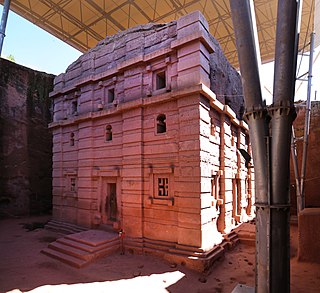
Biete Amanuel is an underground Orthodox monolith rock-cut church located in Lalibela, Ethiopia. The edifice was built during the Kingdom of Axum. It is part of UNESCO World Heritage Site at Lalibela. Biete Amanuel is possibly the former royal chapel.

Biete Abba Libanos is an underground rock-cut monolith Orthodox church located in Lalibela, Ethiopia. It was built during the Kingdom of Axum. It is part of UNESCO World Heritage Site at Lalibela.
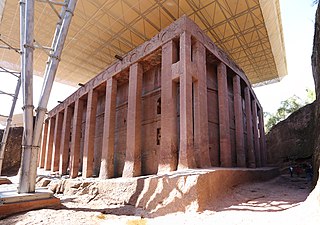
Biete Medhane Alem is an Orthodox underground monolith rock-cut church located in Lalibela, Ethiopia. It was built during the Zagwe dynasty. It is part of the UNESCO World Heritage Site at Lalibela. Biete Medhane Alem is home to the Lalibela Cross.

Biete Maryam is one of the monolithic rock-cut Rock-Hewn Churches, Lalibela of the Ethiopian Orthodox Tewahedo Church. It is part of the UNESCO World Heritage Site at Lalibela.

Biete Meskel is an Orthodox underground monolith church carved into rock. It is located in Lalibela, Ethiopia. The edifice was built during the Kingdom of Axum. It is part of UNESCO World Heritage Site at Lalibela.
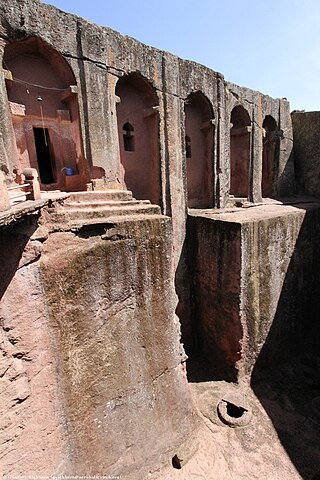
Biete Gabriel-Rufael is an underground monolith rock-cut church located in Lalibela, Ethiopia. The Orthodox church was built during the Kingdom of Axum. It is part of UNESCO World Heritage Site at Lalibela. Biete Gabriel-Rufael is possibly a former royal palace, linked to a holy bakery.

Biete Qeddus Mercoreus is an underground Orthodox rock-cut monolith church located in Lalibela, Ethiopia. It was built during the Kingdom of Axum. It is part of UNESCO World Heritage Site at Lalibela. Biete Qeddus Mercoreus may be a former prison because of ankle shackles found there.
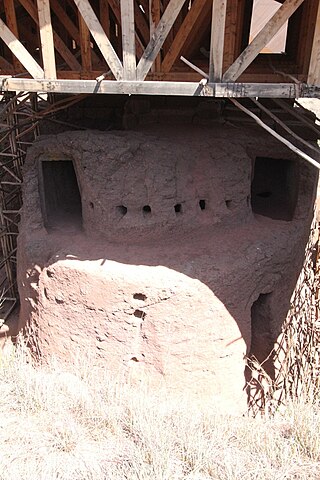
Biete Lehem is an underground monolith church carved into rock. It is located in Lalibela, Ethiopia. It was created during the Kingdom of Axum. It is part of UNESCO World Heritage Site at Lalibela. The name Biete Lehem is from Bethlehem Hebrew: בֵּית לֶחֶם.
The Washa Mikael Rock-Hewn Church is a rock-hewn semi-monolithic church located in the Yeka District of Addis Ababa, the capital city of Ethiopia.

Adadi Mariam is a rock-hewn monolithic church located approximately 66 km southwest of Addis Ababa, Ethiopia. A popular tourist destination, the site is believed to have been built in the 12th century.

The history of Ethiopia in the Middle Ages roughly spans the period from the decline of the Kingdom of Aksum in the 7th century to the Gondarine period beginning in the 17th century. Aksum had been a powerful empire during late antiquity, appearing in the Periplus of the Erythraean Sea and mentioned by Iranian prophet Mani as one of the "four great kingdoms on earth", along with the Sasanian Empire of Persia, the Roman Empire, and China's Three Kingdoms. The kingdom was an integral part of the trade route between Rome and the Indian subcontinent, had substantial cultural ties to the Greco-Roman world, and was a very early adopter of Christianity under Ezana of Aksum in the mid-4th century. The use of "Ethiopia" to refer to the region dates back to the 4th century. At its height, the kingdom spanned what is now Eritrea, northern Ethiopia, eastern Sudan, Yemen and the southern part of what is now Saudi Arabia. However, by the 7th century, the kingdom had begun a slow decline, for which several possible political, economic, and ecological reasons have been proposed. This decline, which has been termed the "Post-Aksumite Period", saw extreme loss of territory and lasted until the ascension of the Zagwe dynasty.

Christian monasticism in Ethiopia has ben practiced since the Aksumite era in the 6th century AD. The Nine Saints from the Byzantine Empire have played crucial roles in the development of monasticism in Ethiopia, which also continued during the Zagwe and Solomonic periods.




























